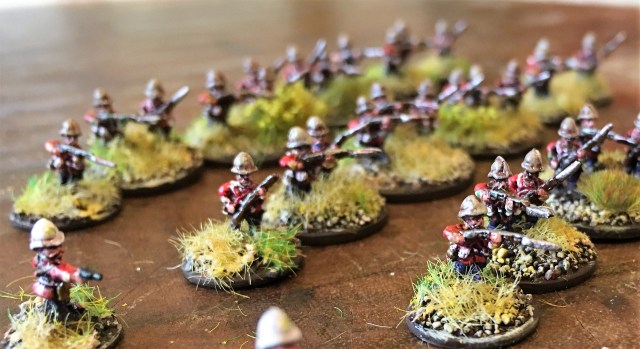 A few things to write about this week, so I better get on with it…
A few things to write about this week, so I better get on with it…
The Men who would be Kings in 6mm
I have to admit that I like the format of the little blue Osprey Wargame booklets (link here). Not all of them have suited my palate in terms of period or type of rules. However, I have bought a fair few of them to date and found most of them interesting and worth a go. One of the earliest I really liked was the Dux Bellorum rules (Arthurian stuff) by Daniel Mersey. I fondly remember trying to figure out the rules one evening after sunset on the Island of Rhodes using some flats I had printed out before the trip. I have since used it to play some games using my Dark Age stuff I did for Saga, which in technically terms in not from the Arthurian period – but none involved seemed to suffer!.
However, this posting is not about Dux Bellorum, but instead relates to another of Daniel’s sets (also published by Osprey) that I want to give a try, namely the Men Who Would be Kings rules. This is a large skirmish rule set derived from his very successful Lion Rampant rules. As implied by the title it is a colonial period rule set.

I have to admit to some, well actually a lot of, 6mm Baccus colonial stuff (link here) on my lead pile that I “will get to one day!”. I have also promised to have a go at trying out “A Steady and Deliberate Rate of Fire” (yet to be published) that seem to be another great set of rules, by Peter Riley who did the Polemos Franco-Prussian war (link here) and the American Civil War rules (link here) . I seem to be a lead mountain away from testing the rules, unless I use some flats but that is more a last resort issue. Sorry Peter, I will get there one day!
What my experience with Sharp Practice has taught me is that it is possible to do skirmish in 6mm that works (see more on this here). With some emphasis on the terrain and playing the game seated instead of standing the immersion is on par with other bigger scales. Further it only requires 40% of the foot print (doing it in centimeters instead of inches) of your normal table. If you pick a range that is well served and have models that are possible to single base easily (like those of Baccus, Rapier and Adler) you can do a good job of it.
I thought I would do a simple set of two forces to try the rules out – I wanted to do some British and Zulus to start with. I find this conflict being one of the most interesting in combination of not needing to buy any new miniatures. Miniatures I have been using are Baccus 6mm form their colonials range and I have been using the 1,2,3 basing method as described by Michael Leck, on his eminent Dalauppror blog, here. By using a combination of 9mm (for leaders),12mm (for singles), 15mm and 20mm bases for infantry and 15mm, and 20mm for cavalry (I did actually a 1,2 basing for these). This is, I think, a very clever way of basing miniatures for large skirmish rules that removes individual miniatures (e.g. Sharp Practice), especially for 6mm that can be a little bit fiddly with small bases. I suppose you just have to make sure you base each unit so that all combinations of models left can be done.
So far I have finished the little British force consisting of 4 units of regular infantry (12 in each unit) and 2 units of regular cavalry (Lanciers, with 8 in each unit). I am very pleased with the way they look and the little space this force takes. I will add a few more unit and some artillery later, but this is enough to get started.


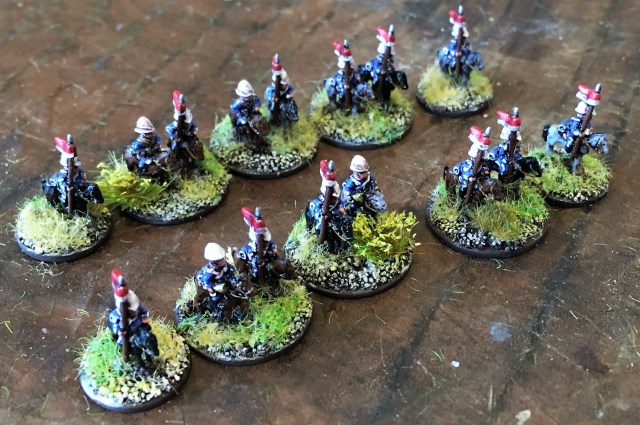
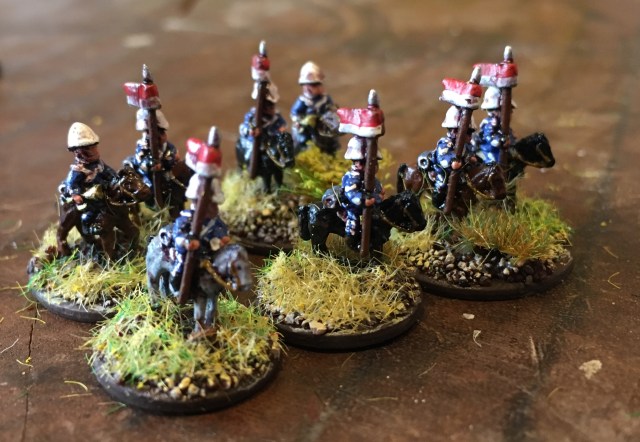
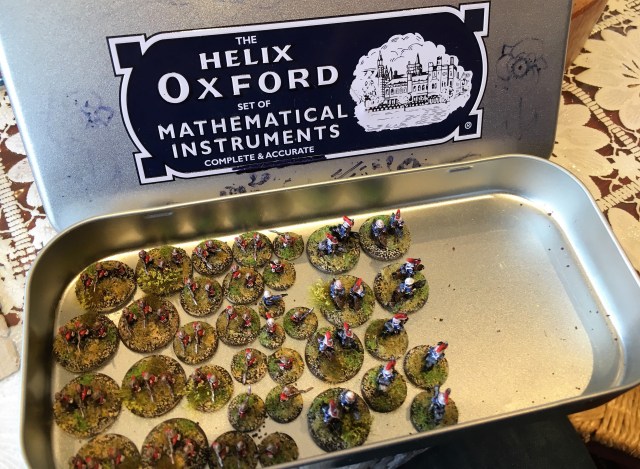
The Zulus are quick to paint and I have to brush up (sorry for the pun) on my Zulu shield knowledge before I can complete them. There is some variation based on marital status and experience (age) if I recall things correctly. I am nearly there though.
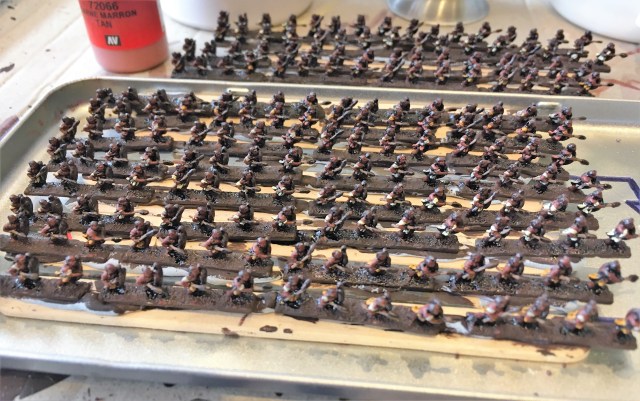
A Welsh Wizard’s tome
I bought the War of 1812 supplement for Sharp Practice penned by Mike Hobbs last week. You might be familiar with Mike if you listen to the Meeples and Miniatures podcast. I am not that familiar with the period but having read it on a train last week I am now resisting getting some miniatures to have a go. There is a thread on what miniatures to use for this in 6mm if you are interested here. I really enjoyed reading it and if you are interested in the period than this is a very good things to get started with even if you do not play Sharp Practice. I actually may end up using the scenarios for my French Indian War battles with a few modifications. The fact that Mike is very enthusiastic about both the Sharp Practice rules in general but more importantly about the period itself shines through and puts that sparkle of magic on top of it all.
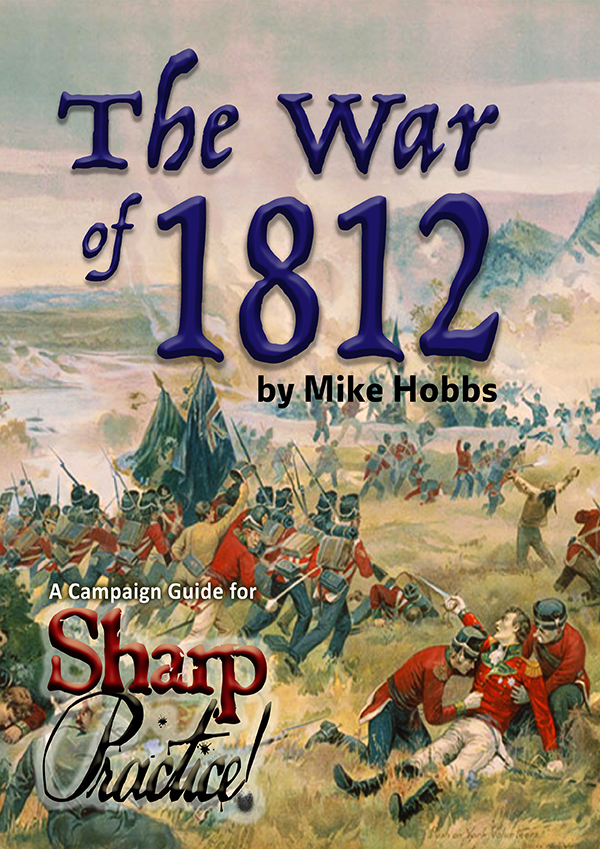
The book contain a listing of the opposing forces and a very good campaign write up for the 41st foot regiment, and seven scenarios. Most of the scenarios are based on the memoirs of Private Shadrach Byfield [A Narrative of a Light Company Soldier’s Service in the Forty-First Regiment of Foot (1807-1814)] and, in my view, offer a wide range of challenges.
Further it introduces a few specific unit characteristics for the War. My favourite is the War Cry that allow an Native Indian unit to instill fear (technically Shock) in another unit. The army lists for both sides covers standard infantry forces, royal marines, militia, scouting forces and native forces (and some cavalry for the Americans). It looks comprehensive enough to me. There is also an overview of the war and two Appendices cover the two armies of the war.
You buy and download the PDF from Too Fat Lardies here.
Terminator Car Wrecks
We needed some more terrain to provide some additional cover for the Terminator games so. This give some additional cover to give the resistance a better chance of winning against the machines.
I and the Little One got some close enough to 28mm scale cars from a charity shop for 20 pence each and stuck them on bases and added some debris on the side (cut up matches, toothpicks, some plastic from a DVD cover and added some various sized stones and mixed it with PVA glue) and, after they were dried, spray painted them grey. Painting left to do, but will do a very good job in breaking up the field of battle.
Focus in Battle
On a funnier note (and repeated from the Roll a One Facebook page) I came home from work one day finding some particular modifications having been done to the Little Ones Nerf gun glasses.
“Why have you stuck pieces of paper on your glasses?”, I asked the Little One.
“They are tactical information screens, it gives me the ability to focus in battle. Got that Private?”
A sleeping hero
The title of this posting – “A prayer’s as good as a bayonet on a day like this” is said by Colour Sergeant Bourne in the movie Zulu (link here). Colour Sergeant (Frank Edward) Bourne was awarded the Distinguished Conduct Medal (CDM) after the Battle at Rourke’s Drift and was, at the time, the youngest soldier in the British Army who had achieved the rank of Colour Sergeant. He ended his career as a Lieutenant Colonel and was awarded an OBE. As I read up about him I found out that he was buried not far from where I live. I think I will take the Little One and have a look for it after Rugby next Sunday. Although he was only 5’6″ tall he was certainly, in every sense of the word, a big man.
/ All the very best, next time I will go through the forces who will be fighting the Kalisz battle at Salute in April this year.






Exellent to see the 1,2,3 basing used för 6 mm 🙂
LikeLike
Wow, I can’t believe those Zulu War figs are only 6mm!!! Outstanding job.
LikeLike
Pingback: Zulus and taking the rusty cars for a spin – Roll a One
Pingback: The Zulus who would be Shakas – our first game of the Men who would be Kings rules – Roll a One
Pingback: Pruth Campaign Skirmish Action in 6mm using Pikeman’s Lament – Part 1: The planning and the buying & some other stuff – Roll a One
Pingback: Pruth Campaign Skirmish Action in 6mm using Pikeman’s Lament – Part 2: The painting and the basing – Roll a One
Pingback: 2017 ending 2018 coming! – Roll a One
Pingback: Mahdist War, Battle of Kirbekan 1885 – making a start – Roll a One
Pingback: A Sharp Practice Force for the Mutant 1984 project and Colour Sergeant Bourne from Zulu – Roll a One